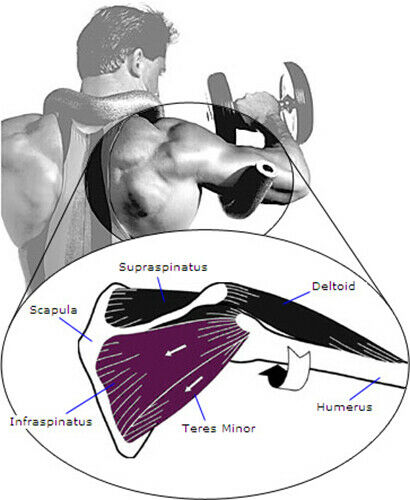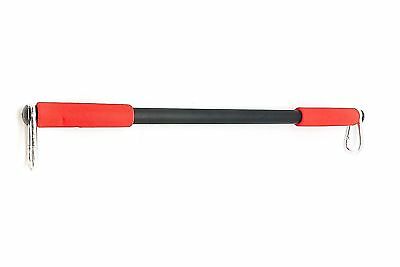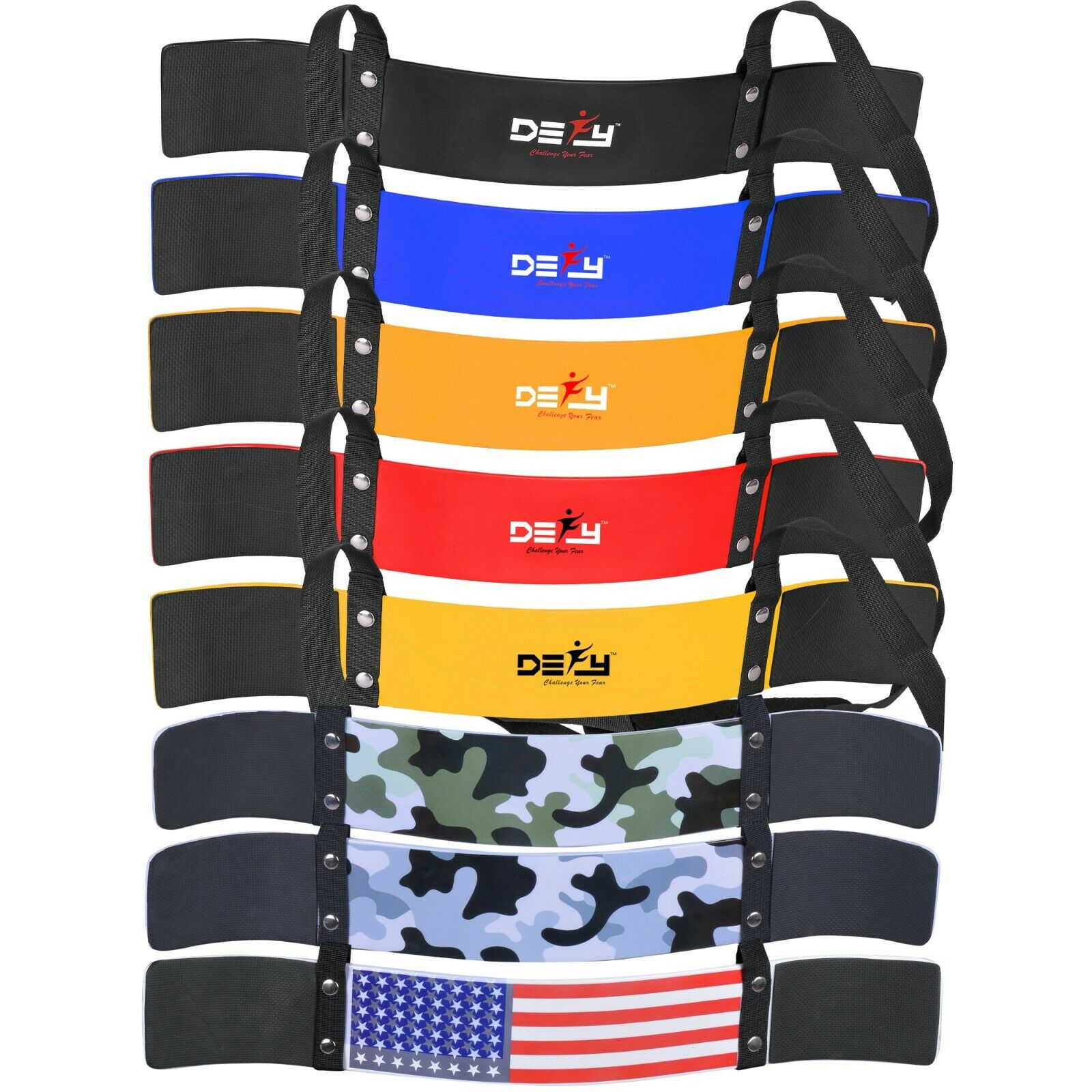-40%
Shoulder Horn Rotator Cuff Training Device (Instructional Booklet Included)
$ 39.6
- Description
- Size Guide
Description
Size 1(XS/S): For heights up to 5'5" and weights up to 140 lbs
Size 2
(M/L): For heights up to 6' and weights up to 200 lbs
Size 3
(XL/XXL): For heights over 6' and weights over 200 lbs
Size 4
(XXXL) For over 200 pounds
Almost all athletic activities stimulate your internal rotators to a much greater degree than your external rotators. Throwing a baseball, serving a tennis ball, and bench pressing a weight are just a few examples. By repetitively performing such activities, your internal rotators are strengthened while your external rotators become relatively weaker. Gradually, the structure of your shoulder is compromised. Your upper arm shifts a little bit forward in the GH joint and presses a little harder on the surrounding nerves, your internal rotators shorten slightly and tighten, and your external rotators lose some of their original tone. Your shoulder strength begins to erode, and you increasingly experience incidents of nonspecific shoulder pain.
Correct Your Muscular Imbalance with a Simple & Effective Rehabilitation Program
If your shoulder dysfunction is the result of a muscular imbalance, the cure is to make adjustments to your exercise program that counter this imbalance. Specifically, you'll need to stretch your internal rotators (to allow your shoulders to return to a more natural position) and strengthen your external rotators (to increase your shoulders' stability).
Almost any stretching movement that forces your upper arms backward and upward will stretch your internal rotators. One of our favorites is a simple pectoral stretch, performed one arm at a time. Begin by standing beside a vertical structure, such as a doorway or the corner of a building. Place your palm and forearm against the structure, with your elbow bent 90 degrees and at approximately shoulder height. Take a small step forward and slowly rotate your body away from your raised arm. Maintain a gentle but persistent stretch across the front of your shoulder for at least 20 seconds, then repeat for your opposite shoulder.
Strengthening your external rotators is the most challenging part of your rehabilitation, because very few exercises stimulate the infraspinatus and teres minor directly, and it's easy to perform those exercises improperly. That's exactly why the ShoulderHorn was created.
Use the ShoulderHorn to Isolate and Strengthen Your External Rotators
The external rotation exercise is similar to a tennis backhand stroke -- your elbow is bent 90 degrees and stays in one position, while your hand and forearm pivot backward. This exercise can be done either with your upper arm held flat against your side or with your arm partially raised (horizontally abducted). From an athlete's standpoint, there are two compelling reasons to perform this exercise in the abducted position:
Better neuromuscular preparation for overhead exertion
Horizontal abduction better approximates the position of your shoulder when it's under greatest load during the lifting, throwing, and overhead motions common to many sports (e.g. baseball, football, weight lifting, tennis, swimming). Performing the exercise in an abducted position better conditions your external rotators to respond appropriately when most needed.
Relief of supraspinatus compression
One of your other rotator cuff muscles -- the supraspinatus -- occupies a confined space along the top of your scapula, and can experience compression-induced disruption of its blood supply when forces are applied to your shoulder in a fully adducted (arm down) position. This potential problem is eliminated by use of the abducted position.
External rotation in an abducted position should only be done with proper support, however. If the weight of your upper arms isn't completely supported, other muscles of your shoulder and upper back (e.g. deltoid, trapezius) will activate and decrease the amount of benefit your infraspinatus and teres minor receive from this exercise. In addition, if the position of your upper arm is to high or too far back, there's a risk of impingement between your humerus and acromion (the hook-shaped bone structure at the top of your scapula).
The ShoulderHorn automatically locks your shoulders and arms in the
safest and most effective position for abducted external rotation
. The ShoulderHorn has also been
clinically proven
to be significantly more effective for increasing external rotator strength than dumbbells alone.
Use the ShoulderHorn with a pair of hand-held weights, as shown below. Beginners may use as little as 2 lbs of weight for this movement, and even the strongest athletes will need less than 20 lbs. For this reason, a small medicine ball, or even a can of soup, can provide suitable resistance if dumbbells aren't available. A training booklet, included with the ShoulderHorn, provides additional details on this exercise and how to best incorporate it into your training or rehabilitation schedule.
Your Shoulder Pain May Be the Result of a Muscular Imbalance
What we commonly call the "shoulder joint" is referred to by doctors as the gleno-humeral (GH) joint. This is the point where your upper arm (i.e. humerus) attaches to the lateral end of your shoulder blade (i.e. scapula). Most of your shoulder's motion is due to movement of your arm at the GH joint. The remainder is caused by smaller movements of the scapula.
The GH joint is a shallow ball-and-socket joint that allows your arm to move freely in all directions. This joint's inherent flexibility, however, makes it relatively unstable. It's function depends heavily on the coordinated strength of the surrounding muscles. To better understand this instability, consider the following analogy:
Imagine your upper arm as being a large tent pole, extending upward from the ground. Your shoulder is the point on the ground where the tent pole rests. Your shoulder muscles are then the ropes or guy wires that hold the tent pole in position. As long as all of these guy wires remain strong and tensioned, the pole maintains its proper position, and the tent maintains its integrity. However, if any of the guy wires break, stretch, or loose tension, the remaining guy wires will pull the pole out of position, and the tent will collapse.
Your deltoids, pectorals, latissimus dorsi, teres major, and rotator cuff muscles (subscapularis, supraspinatus, infraspinatus, and teres minor) all cross the shoulder joint and attach to your upper arm. In addition to moving your arm, they help hold its proper position in the GH joint. Because these muscles have different origins of attachment, each one, like the guy wires, pulls your arm in a different direction.
Shoulder muscles are commonly classified as being either internal rotators or external rotators. The largest shoulder muscles, including the pectorals, latissimus dorsi, and teres major, are all internal rotators. This means that in addition to moving your arm forward or backward, they also cause some inward rotation of your arm. The corresponding external rotation is produced almost entirely by two small muscles of the rotator cuff -- the infraspinatus and the teres minor.











